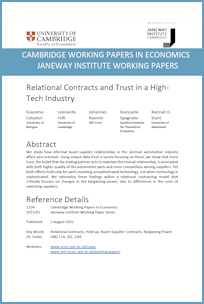
Ruiz-García, J. C.
Financial Frictions, Firm Dynamics and the Aggregate Economy: Insights from Richer Productivity Processes
JIWP Number: 2103
Abstract: How do financial frictions affect firm dynamics, allocation of resources across firms, and aggregate productivity and output? Is the nature of productivity shocks that firms face primary for the effects of financial frictions? I first use a comprehensive dataset of Spanish firms from 1999 to 2014 to estimate non-parametrically the firm productivity dynamics. I find that the productivity process is non-linear, as persistence and shock variability depend on past productivity, and productivity shocks are non-Gaussian. These dynamics differ from the ones implied by a standard AR(1) process, commonly used in the firm dynamics literature. I then build a model of firm dynamics with financial frictions in which productivity shocks are non-linear and non-Gaussian. The model is consistent with a host of evidence on firm dynamics, financial frictions, and firms’ financial behaviour. In the model economy, financial frictions affect the firm life cycle. Without financial frictions, the size of an entrant firm will be three times larger. Furthermore, profit accumulation, which allows firms to overcome financial frictions, is slow, and it only speeds up when firms are mature. As a consequence, the average exiting firm is smaller than it would be without financial frictions. The aggregate consequences of financial frictions are significant. They result in misallocation of capital and reduce aggregate productivity by 16%. This figure is only 8% if productivity dynamics evolve according to a standard AR(1) process.
Keywords: Financial Frictions, Firm Dynamics, Misallocation, Non-Linear Productivity Process
JEL Codes: E22 G32 O16
Author links:
PDF: jiwp2103.pdf 
Open Access Link: 10.17863/CAM.74481
